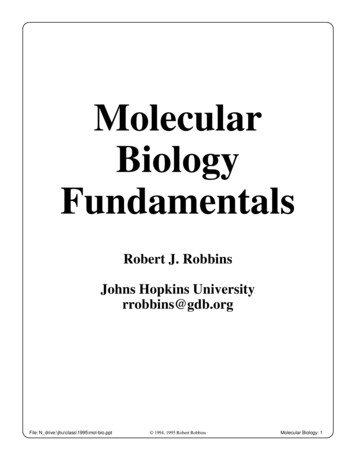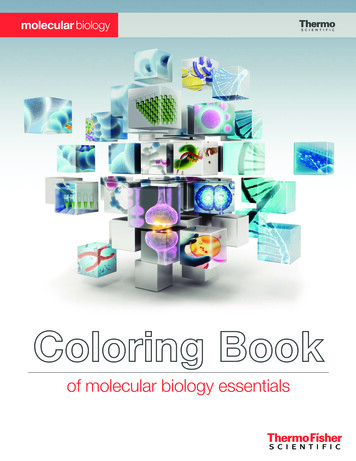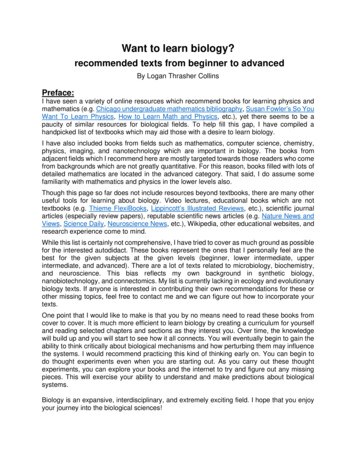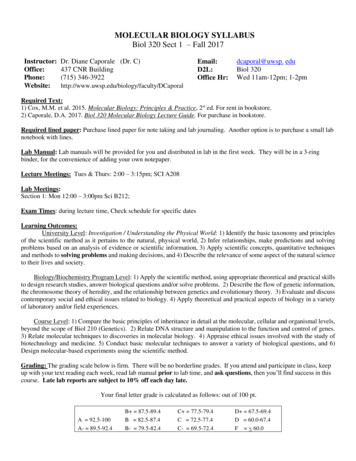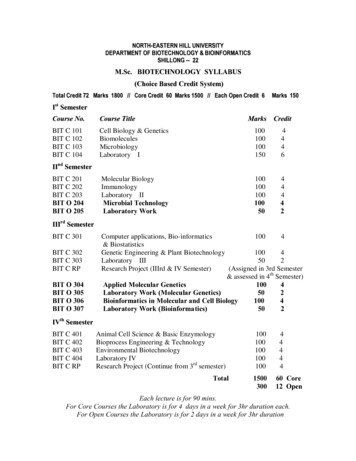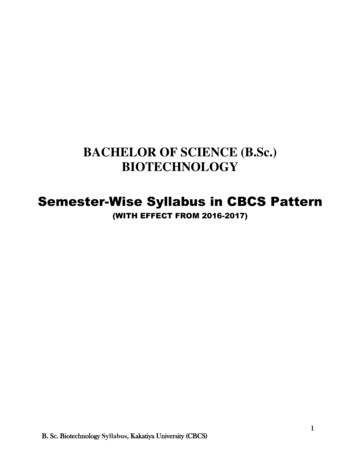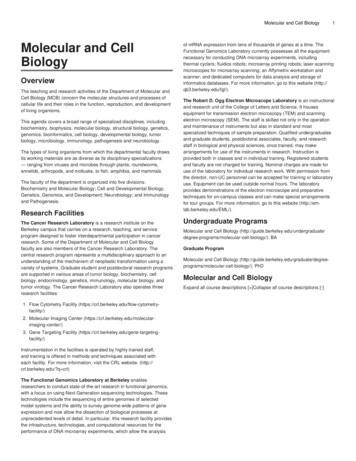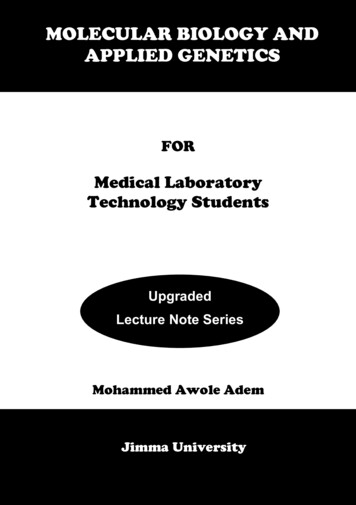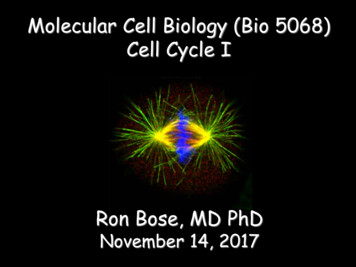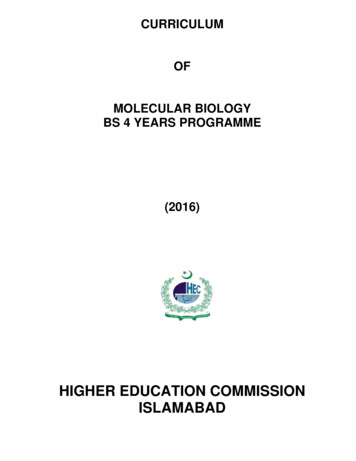
Transcription
MolecularBiologyClark1570247PRELIMS.indd i978-0-12-378594-7X00011/6/2012 9:49:18 AM
PRELIMS.indd ii1/6/2012 9:49:23 AM
MolecularBiologySecond EditionD a v i d P. C l a r kNanette J. PazdernikAMSTERDAM BOSTON HEIDELBERG LONDONNEW YORK OXFORD PARIS SAN DIEGOSAN FRANCISCO SINGAPORE SYDNEY TOKYOAcademic Press is an imprint of ElsevierClark1570247PRELIMS.indd iii978-0-12-378594-7X00011/6/2012 9:49:26 AM
Academic Press is an imprint of Elsevier225 Wyman Street, Waltham, MA 02451, USAThe Boulevard, Langford Lane, Kidlington, Oxford, OX5 1GB, UKCopyright 2013 Elsevier Inc. All rights reservedNo part of this publication may be reproduced or transmitted in any form or by any means, electronic ormechanical, including photocopying, recording, or any information storage and retrieval system, withoutpermission in writing from the Publisher. Details on how to seek permission, further information aboutthe Publisher’s permissions policies and our arrangements with organizations such as the CopyrightClearance Center and the Copyright Licensing Agency, can be found at our website: www.elsevier.com/permissionsThis book and the individual contributions contained in it are protected under copyright by thePublisher (other than as may be noted herein).NoticesKnowledge and best practice in this field are constantly changing. As new research and experiencebroaden our understanding, changes in research methods, professional practices, or medical treatmentmay become necessary.Practitioners and researchers must always rely on their own experience and knowledge in evaluatingand using any information, methods, compounds, or experiments described herein. In using suchinformation or methods they should be mindful of their own safety and the safety of others, includingparties for whom they have a professional responsibility.To the fullest extent of the law, neither the Publisher nor the authors, contributors, or editors, assumeany liability for any injury and/or damage to persons or property as a matter of products liability, negligence or otherwise, or from any use or operation of any methods, products, instructions, or ideas contained in the material herein.Library of Congress Cataloging-in-Publication DataClark, David P.Molecular biology / David Clark, Nan Pazdernik. – 2nd ed.p. cm.Includes bibliographical references and index.ISBN 978-0-12-378594-7 (alk. paper)1. Molecular biology. 2. Molecular genetics. I. Pazdernik, Nanette Jean. II. Title.QH506.C533 2013572.8–dc232011038218British Library Cataloguing-in-Publication DataA catalogue record for this book is available from the British LibraryFor information on all Academic Press publicationsvisit our website at www.elsevierdirect.comPrinted in Canada12 13 14 15 10 9 8 7 6 5 4 3 2 1ITR.indd iv1/6/2012 9:52:53 AM
DedicationThis book is dedicated to Lonnie Russell who was to have been my coauthoron the first edition. A few months after we started this project together, in earlyJuly 2001, Lonnie drowned in the Atlantic Ocean off the coast of Brazil ina tragic accident.DPCTo my family, especially my husband and my three children. They have givenme the gift of time, courage, and strength. Time to actually write, courage tocontinue even when I was tired, and the strength to do my very best work nomatter the circumstances.NJPDED.indd v1/6/2012 9:52:29 AM
DED.indd vi1/6/2012 9:52:29 AM
Preface to second editionThe last quarter of the 20th century saw major scientific revolutions in genetics andcomputer technology. Indeed, handling the vast amounts of genetic information generated nowadays depends on advanced computer technology. This book reflects thismassive surge in our understanding of the molecular foundations of genetics. Today,we now know that genes are much more than the abstract entities proposed over acentury ago by Mendel. Genes are segments of DNA molecules, carrying encodedinformation. Indeed, genes have now become chemical reagents to be manipulated inthe test tube in ever more complex ways. Over the next half century our understanding of how living organisms function at the molecular level, together with our abilityto intervene, will expand in ways we are only just beginning to perceive.A full understanding of how living organisms function includes an appreciationof how cells operate at the molecular level. This is of vital importance to all of us as itbecomes ever more clear that molecular factors underlie many health problems anddiseases. While cancer is the “classic” case of a disease that only became understandable when its genetic basis was revealed, it is not the only one by any means. Today,the molecular aspects of medicine are expanding rapidly and it is becoming possibleto tailor clinical treatment personally by taking into account the genetic make-up ofindividual patients, an area known as personal genomics.This book is intended as a survey-oriented textbook for upper-division studentsin a variety of biological subdisciplines. In particular, it is aimed at final-year undergraduates and beginning graduate students. This book does not attempt to be exhaustive in its coverage, even as a textbook. There is a second book in this series, entitled“Biotechnology,” which emphasizes the more practical applications of modern genetics. We hope that both books together effectively survey the foundations and applications of modern molecular genetics.Some of the students using this book will be well-versed in the basics of modern molecular biology, having taken courses in genetics, biochemistry, and cell biology. However, others will not be so well-prepared, in part due to the continuing influxof students into molecular biology from biology programs that are not oriented in amolecular direction. For them we have tried to create a book whose early chapterscover the basics before launching out into the depths. The first unit of five chapterscovers basic cell structure and genetics. This is followed by a survey of DNA, RNA,and proteins and how they interact to provide the cell with genetic information.Because of the continuing interest in applying molecular biology to an everwidening array of topics, we have tried to avoid overdoing detail (depth) in favorof breadth. Molecular biology is applicable to more than just human medicine andhealth. The genetic revolution has also greatly impacted other important areas suchas agriculture, veterinary medicine, animal behavior, evolution, and microbiology.Students of these, and related disciplines, will all benefit from an improved understanding of molecular biology.Changes in the Second EditionThis edition includes significant changes in comparison to the first edition ofMolecular Biology.The flood of new sequence information has necessitated updates to many areasof the book, especially Genomics and Systems Biology (Ch. 9), Proteomics (Ch. 15)Bacterial Genetics (Ch. 25), and Molecular Evolution (Ch. 26). Perhaps the mostrapidly-changing area of molecular biology at present is the ever-expanding role ofRNA. Although scattered items occur throughout the book, particularly in Unit 4,most of the major novel RNA topics, such as CRISPR and long-non-coding RNA, aregrouped together in Chapter 18, Regulation at the RNA level.PRE.indd viivii1/6/2012 9:55:11 AM
viiiPrefaceIn this second edition we have re-ordered some of the chapters in a more logicalorder. In particular, chapters on DNA technology and genomics that were toward theend of the book have been moved far forward. This reflects the much greater role thatsequence analysis and genomics have come to play in the last two or three years.We have also divided the book into modules, each of several related chapters. Thefirst module contains introductory material that experienced students can either skipor skim through rapidly for the reasons cited above. Sections within chapters havebeen numbered to aid in cross-reference. Review questions and conceptual problemsare now provided at the end of each chapter.A new text element, “Focus on Relevant Research,” now appears throughout thebook. These feature discussions of recent papers in the field published by Cell Press.The content focuses on helping the student learn how to read and understand primaryliterature in hopes of preparing them for the scientific world. The complete articlesare also provided on the accompanying website for easy reference by students andinstructors.The website also includes access to the Focus on Relevant Research Case Studiesthat discuss the main topics of each chapter and build case studies around the contentto help students understand the basics of primary literature while allowing them tomake the appropriate connections to the text.Other online materials to supplement the text include flashcards, animations,quizzes to prepare for tests, and PowerPoint slides with images for note-taking.Students also have access to online references as they can then be directly linked toInternet databases, such as PubMed or ScienceDirect .Instructors also have access to the images from the book and test banks based onthe text and accompanying journal articles.We look forward to hearing about your experiences, whether you use ourbook for teaching or studying. Please send your comments, criticisms, and advice toMolecularBiologyAC2@elsevier.com. Thank you!David Clark and Nan Pazdernik,Carbondale, Illinois, April 2011PRE.indd viii1/6/2012 9:55:12 AM
AcknowledgementsWe would like to thank the following individuals for their help in providing information, suggestions for improvement and encouragement: Malikah Abdullah-Israel,Laurie Achenbach, Steven Ackerman, Rubina Ahsan, Kasirajan Ayyanathan, MarilynBaguinon, Joan Betz, Blake Bextine, Gail Breen, Douglas Burks, Mehmet Candas,Jung-ren Chen, Helen Cronenberger, Phil Cunningham, Dennis Deluca, LindaDeVeaux, Elizabeth De Stasio, Justin DiAngelo, Susan DiBartolomeis, Brian Downes,Ioannis Eleftherianos, Robert Farrell, Elizabeth Blinstrup Good, Joyce Hardy, DavidL. Herrin, Walter M. Holmes, Karen Jackson, Mark Kainz, Nemat Keyhani, RebeccaLandsberg, Richard LeBaron, Richard Londraville, Larry Lowe, Charles Mallery,Boriana Marintcheva, Stu Maxwell, Michelle McGehee, Ana Medrano, ThomasMennella, Donna Mueller, Khalil Nezhad , Dan Nickrent, Monica Oblinger, RekhaPatel, Marianna Patrauchan, Neena Philips, Wanda Reygaert, Veronica Riha, PhillipRyals, Donald Seto, Dan Simmons, Joan Slonczewski, Malgosia Wilk-Blaszczak,Hongzhuan Wu and Ding Xue.ixACK.indd ix1/6/2012 9:54:38 AM
ACK.indd x1/6/2012 9:54:38 AM
ContentsUNIT 1 BASIC CHEMICALANDBIOLOGICAL PRINCIPLES1CHAPTER 1 Cells and Organisms21. What Is Life?2. Living Creatures Are Made of Cells3. Eubacteria and Archaea Are GeneticallyDistinct4. Eukaryotic Cells Are Subdivided intoCompartments5. The Diversity of Eukaryotes6. Haploidy, Diploidy, and the Eukaryote Cell Cycle7. Organisms Are Classified8. Some Widely-Studied Organisms Serve as Models9. Basic Characteristics of a Model Organism10. Purifying DNA from Model Organisms11. Viruses Are Not Living Cells12. Bacterial Viruses Infect Bacteria13. Human Viral Diseases Are Common14. A Variety of Subcellular Genetic Entities ExistKey ConceptsReview QuestionsConceptual Questions34CHAPTER 2 Basic Genetics1. Gregor Mendel, The Father of Classical Genetics2. Genes Determine Each Step in BiochemicalPathways3. Mutants Result from Alterations in Genes4. Phenotypes and Genotypes5. Chromosomes Are Long, Thin MoleculesThat Carry Genes6. Dominant and Recessive Alleles7. Genes from Both Parents Are Mixed by SexualReproduction8. Neighboring Genes Are Linked DuringInheritance Unless the DNA Recombines9. Identifying Genes that Cause Human DiseasesKey ConceptsReview QuestionsConceptual 53637373940414245485257585960CHAPTER 3 DNA, RNA, and Protein621. History of DNA as the Genetic Material2. Nucleic Acid Molecules Carry GeneticInformation3. Chemical Structure of Nucleic Acids4. Double-Stranded DNA Forms a Double Helix62PRELIMS1.indd xi5. Constituents of Chromosomes6. The Central Dogma Outlines the Flow ofGenetic Information7. Ribosomes Read the Genetic Code8. Various Classes of RNA Have Different Functions9. Proteins Carry Out Many Cell FunctionsKey ConceptsReview QuestionsConceptual Questions636367CHAPTER 4 Genomes and DNA1. Genome Organization2. Repeated Sequences Are a Feature ofEukaryotic DNA3. Palindromes, Inverted Repeats, and Stem andLoop Structures4. Multiple A-Tracts Cause DNA to Bend5. Supercoiling Is Necessary for Packagingof Bacterial DNA6. Separation of DNA Fragments byElectrophoresis7. Alternative Helical Structures of DNA Occur8. Packaging DNA in Eukaryotic NucleiKey ConceptsReview QuestionsConceptual Questions9494100105106106111113116121122123CHAPTER 5 Manipulation ofNucleic Acids1. Manipulating DNA2. Chemical Synthesis of DNA3. Measuring the Concentration of DNA andRNA with Ultraviolet Light4. Radioactive Labeling of Nucleic Acids5. Fluorescence in the Detection of DNA and RNA6. The Electron Microscope7. Hybridization of DNA and RNAKey ConceptsReview QuestionsConceptual QuestionsUNIT 2 THE GENOME125126135143144146149151158158159162CHAPTER 6 PolymeraseChain Reaction1631. Fundamentals of the Polymerase Chain Reaction 1642. Inverse PCR1711/9/2012 8:39:10 PM
xiiContents3. Randomly Amplified Polymorphic DNA(RAPD)4. Reverse Transcriptase PCR5. Differential Display PCR6. Rapid Amplification of cDNA Ends (RACE)7. PCR in Genetic Engineering8. Directed Mutagenesis9. Engineering Deletions and Insertionsby PCR10. Real-Time Fluorescent PCR11. Molecular Beacons and Scorpion Primers12. Use of PCR in Medical Diagnosis13. Environmental Analysis by PCR14. Rescuing DNA from Extinct Life Formsby PCRKey ConceptsReview QuestionsConceptual 2193CHAPTER 7 Cloning Genesfor Analysis1. Properties of Cloning Vectors2. Detecting Insertions in Vectors3. Moving Genes Between Organisms:Shuttle Vectors4. Bacteriophage Lambda Vectors5. Cosmid Vectors6. Yeast Artificial Chromosomes7. Bacterial and P1 Artificial Chromosomes8. Recombineering Increases the Speed ofGene Cloning9. A DNA Library is a Collection of Genesfrom One Source10. Cloning Complementary DNA AvoidsIntrons11. Chromosome Walking12. Cloning by Subtractive Hybridization13. Expression VectorsKey ConceptsReview QuestionsConceptual QuestionsCHAPTER 8 DNA Sequencing1. DNA Sequencing—General Principles forChain Termination Sequencing2. Primer Walking Along a Strand of DNA3. Automated Sequencing4. Cycle Sequencing5. The Emergence of DNA Chip Technology6. Pyrosequencing7. Second-Generation SequencingPRELIMS1.indd xii1941951992012052062082088. Third-Generation Sequencing9. Nanopore Detectors for DNAKey ConceptsReview QuestionsConceptual QuestionsCHAPTER 9 Genomics & SystemsBiology1. Large-Scale Mapping with Sequence Tags2. Assembling Small Genomes by ShotgunSequencing3. Race for the Human Genome4. Survey of the Human Genome5. Pharmacogenomics—GeneticallyIndividualized Drug Treatment6. Personal Genomics and ComparativeGenomics7. Bioinformatics and Computer Analysis8. Systems Biology9. Metagenomics and Community Sampling10. Epigenetics and EpigenomicsKey ConceptsReview QuestionsConceptual QuestionsOFMOLECULAR BIOLOGYCHAPTER 10 Cell Division and212DNA 263264265266268268269271271UNIT 3 THE CENTRAL DOGMA2092152172192202232242252422432442462461. Cell Division and Reproduction Are NotAlways Identical2. DNA Replication Occurs at the Replication Fork3. Properties of DNA Polymerase4. Nucleotides Are the Precursors forDNA Synthesis5. DNA Polymerase Elongates DNA Strands6. The Complete Replication Fork Is Complex7. Discontinuous Synthesis of the Lagging Strand8. Chromosome Replication Initiates at oriC9. Chromosome Replication Terminates at terC10. Cell Division in Bacteria Occurs afterReplication of Chromosomes11. The Concept of the Replicon12. Replicating Linear DNA in Eukaryotes13. Cell Division in Higher OrganismsKey ConceptsReview QuestionsConceptual 83043053073081/9/2012 8:39:10 PM
ContentsCHAPTER 11 Transcription of Genes1.2.3.4.5.Genes Are Expressed by Making RNAHow Is the Beginning of a Gene Recognized?Manufacturing the MessageRNA Polymerase Knows Where to StopHow Does the Cell Know Which Genes toTurn On?6. Transcription in Eukaryotes Is MoreComplexKey ConceptsReview QuestionsConceptual QuestionsCHAPTER 12 Processing of RNA1.2.3.4.RNA Is Processed in Several WaysCoding and Non-Coding RNAProcessing of Ribosomal and Transfer RNAEukaryotic Messenger RNA Contains aCap and a Tail5. Introns Are Removed from RNA by Splicing6. Alternative Splicing Produces MultipleForms of RNA7. Inteins and Protein Splicing8. Base Modification of rRNA Requires GuideRNA9. RNA Editing Alters the Base Sequence10. Transport of RNA out of the Nucleus11. Degradation of mRNAKey ConceptsReview QuestionsConceptual 834034434935235535836036136636736712. Protein Synthesis Occursin Mitochondria and Chloroplasts13. Mistranslation Usually Results in Mistakes inProtein Synthesis14. Many Antibiotics Work by Inhibiting ProteinSynthesis15. Post-Translational Modifications of Proteins16. Selenocysteine and Pyrrolysine: Rare AminoAcids17. Degradation of ProteinsKey ConceptsReview QuestionsConceptual Questionsxiii405407408408410412415415416CHAPTER 14 Protein Structure andFunction1. The Structure of Proteins Reflects Four Levelsof Organization2. Determining Protein Structures3. Nucleoproteins, Lipoproteins, andGlycoproteins Are Conjugated Proteins4. Proteins Serve Numerous Cellular Functions5. Protein (Nano)-Machines6. Enzymes Catalyze Metabolic Reactions7. Binding of Proteins to DNA Occurs in SeveralDifferent Ways8. Denaturation of ProteinsKey ConceptsReview QuestionsConceptual ER 15 Proteomics: The GlobalCHAPTER 13 Protein Synthesis1.2.3.4.5.6.7.8.9.10.11.Overview of Protein SynthesisProteins Are Chains of Amino AcidsDecoding the Genetic InformationThe Ribosome: The Cell’s Decoding MachineThree Possible Reading Frames ExistThe tRNA Occupies Three Sites DuringElongation of the PolypeptideBacterial mRNA Can Code for SeveralProteinsSome Ribosomes Become Stalled and AreRescuedDifferences between Eukaryotic andProkaryotic Protein SynthesisProtein Synthesis Is Halted When ResourcesAre ScarceA Signal Sequence Marks a Protein forExport from the CellPRELIMS1.indd xiii369370371376381386389394395397401403Analysis of Proteins1.2.3.4.5.The ProteomeAntibodies Are Essential Proteomics ToolsWestern Blotting of ProteinsIsolating Proteins with ChromatographyMass Spectrometry for ProteinIdentification6. Protein-Tagging Systems7. Selection by Phage Display8. Protein Interactions: The Yeast Two-HybridSystem9. Protein Interaction byCo-Immunoprecipitation10. Protein Arrays11. MetabolomicsKey ConceptsReview QuestionsConceptual 04911/9/2012 8:39:10 PM
xivContentsUNIT 4 REGULATING GENE EXPRESSION 492CHAPTER 16 Regulation ofTranscription inProkaryotes1. Gene Regulation Ensures a PhysiologicalResponse2. Regulation at the Level of TranscriptionInvolves Several Steps3. Alternative Sigma Factors in ProkaryotesRecognize Different Sets of Genes4. Activators and Repressors Participate inPositive and Negative Regulation5. Two-Component Regulatory Systems6. Specific versus Global Control7. Accessory Factors and Nucleoid-BindingProteins8. Anti-Termination as a Control MechanismKey ConceptsReview QuestionsConceptual ER 17 Regulation ofTranscription inEukaryotes1. Transcriptional Regulation in Eukaryotes IsMore Complex Than in Prokaryotes2. Specific Transcription Factors RegulateProtein-Encoding Genes3. Negative Regulation of Transcription Occurs inEukaryotes4. Heterochromatin Blocks Access to DNA inEukaryotes5. Methylation of Eukaryotic DNA ControlsGene Expression6. X-Chromosome Inactivation Occurs inFemale XX AnimalsKey ConceptsReview QuestionsConceptual Questions1.2.3.4.Regulation at the Level of mRNABasic Principles of RNA Interference (RNAi)Long Non-coding Regulatory RNACRISPR: Anti-Viral Defense in BacteriaPRELIMS1.indd xiv574576579579580CHAPTER 19 Analysis of GeneExpression1. Monitoring Gene Expression2. Reporter Genes for Monitoring GeneExpression3. Deletion Analysis of the Upstream Region4. DNA-Protein Complexes Can Be Isolated byChromatin Immunoprecipitation5. Location of the Start of Transcription by PrimerExtension6. Transcriptome Analysis7. DNA Microarrays for Gene Expression8. TaqMan Quantitative PCR to Assay GeneExpression9. Serial Analysis of Gene Expression (SAGE)Key ConceptsReview QuestionsConceptual 6UNIT 5 SUBCELLULAR LIFE FORMS615CHAPTER 20 Plasmids616526527533537543547550550551CHAPTER 18 Regulation at theRNA Level5. Premature Termination Causes Attenuationof RNA Transcription6. Riboswitches—RNA Acting Directly as aControl MechanismKey ConceptsReview QuestionsConceptual Questions5535535645725731. Plasmids as Replicons2. General Properties of Plasmids3. Plasmid DNA Replicates by Two AlternativeMethods4. Many Plasmids Help their Host Cells5. Plasmids may Provide Aggressive Characters6. Ti Plasmids are Transferred fromBacteria to Plants7. The 2μ Plasmid of Yeast8. Certain DNA Molecules May Behave asViruses or PlasmidsKey ConceptsReview QuestionsConceptual QuestionsCHAPTER 21 Viruses1. Viruses Are Infectious Packages of GeneticInformation2. The Great Diversity of /9/2012 8:39:10 PM
Contents3. Viruses with RNA Genomes HaveVery Few Genes4. Retroviruses Use both RNA and DNA5. Subviral Infectious AgentsKey ConceptsReview QuestionsConceptual QuestionsCHAPTER 22 Mobile DNA1. Subcellular Genetic Elements as GeneCreatures2. Most Mobile DNA Consists of TransposableElements3. Retroelements Make an RNA Copy4. The Multitude of Transposable Elements5. Junk DNA and Selfish DNAKey ConceptsReview QuestionsConceptual 8719UNIT 6 CHANGING THE DNABLUEPRINTCHAPTER 23 Mutations and Repair1.2.3.4.5.6.Mutations Alter the DNA SequenceThe Major Types of MutationChemical Mutagens Damage DNAOverview of DNA RepairMutations Occur More Frequently at HotspotsReversions Are Genetic Alterations ThatChange the Phenotype Back to Wild-Type7. Site-Directed MutagenesisKey ConceptsReview QuestionsConceptual QuestionsCHAPTER 24 Recombination1. Overview of Recombination2. Molecular Basis of Homologous RecombinationPRELIMS1.indd xv7207217217227337427587597637647657667673. Site-Specific Recombination4. Recombination in Higher Organisms5. Gene ConversionKey ConceptsReview QuestionsConceptual QuestionsCHAPTER 25 Bacterial Genetics1. Reproduction versus Gene Transfer2. Fate of the Incoming DNA after Uptake3. Transformation Is Gene Transfer by Naked DNA4. Gene Transfer by Virus—Transduction5. Transfer of Plasmids between Bacteria6. Gene Transfer among Gram-Positive Bacteria7. Archaeal Genetics8. Whole-Genome SequencingKey ConceptsReview QuestionsConceptual QuestionsCHAPTER 26 Molecular 92795801804805808809810812Getting Started—Formation of the EarthOparin’s Theory of the Origin of LifeOrigin of Informational MacromoleculesThe Autotrophic Theory of the Origin ofMetabolism5. Evolution of DNA, RNA, and Protein Sequences6. Different Proteins Evolve at Very Different Rates7. Symbiotic Origin of Eukaryotic Cells8. DNA Sequencing and Biological Classification9. Evolving Sideways: Horizontal Gene TransferKey ConceptsReview QuestionsConceptual 418478508518527677691/9/2012 8:39:10 PM
Molecular Biology . The fl ood of new sequence information has necessitated updates to many areas of the book, especially Genomics and Systems Biology (Ch. 9), Proteomics (Ch. 15) Bacterial Genetics (Ch. 25), and Molecular Evolution (Ch. 26). Perhaps the most rapidly-changing area of molecular biology at present is the ever-expanding role of RNA.
